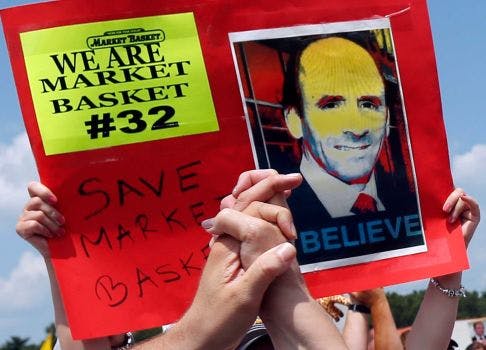Last summer I chronicled the story of the Market Basket revolt (here, here, and here).
To summarize, two cousins (both named Arthur, just to keep things interesting) owned the company. Arthur S. DeMoulas (ASD) had 51 percent ownership and ran the board. Arthur T. DeMoulas (ATD) had 49 percent and the heart of employees.
When ATD was pushed out of the organization, employees staged walk-outs, stopped product delivery to stores, and encouraged customers to shop elsewhere. In short, they fought for the leader they believed in.
But here’s the kicker: These were non-union employees. Was it all altruistic? Maybe not.
ATD continually pushed for low prices for customers and high pay for employees. ASD was perceived to push for more money to shareholders, with the downstream effect of necessarily changing that business model. Many point out employees were fighting not just for ATD but also for the exceptional pay and benefits they enjoyed as retail employees.
Ultimately, ATD won, taking on exceptional debt (which had not been done before) to buy out his cousin and assume sole ownership.
How they did it
So, a year later, where do we stand? Per The Boston Globe:
Its prices remain lower than its competition, according to independent studies (though they have grown year-over-year, according to another study), and the company has put hundreds of millions of dollars into retirement accounts and bonus checks since last year. What’s more, David McLean, Market Basket’s director of operations, said Market Basket is ahead of schedule on paying back the debt.”
How did they do it? Yes, they opened new stores, generating new business. But the real story of how they recovered from a multi-month system-wide near shutdown really centers on one factor, the same factor that led the shutdown in the first place – the employees.
Again, according to the Globe:
Market Basket has always been run efficiently. A long history of promoting from within and developing employee loyalty has helped it keep low management overhead, with most senior employees having begun their careers as bag boys and sticking with the company for decades …
While Arthur S. may have had reason for his grocery beef, he did not have the support of Market Basket’s constituents. Arthur T. had long emphasized a focus on employees. ‘Without them this place goes down the tubes quicker than you can say hi-ho,’ he told the company’s board in 2009 while defending a bonus plan.”
“Employees first” the key to success
The “employees first” model has proved, time and again, to be the primary factor for company success. It’s relatively simple. Happy, engaged employees are more focused on creating happy, engaged customers, who in turn drive the value shareholders are seeking. But we must first invest in our employees.
We must foster those deep and abiding relationships among employees at every level that encourages people to band together for the good of each other, the customer and company. It’s those relationships that sustain in difficult times and give us reason to celebrate in good times.
The basis of any good relationship is simply noticing the other person, seeing what they do, acknowledging them for their efforts, and praising their good work. It’s about caring about others enough to lift ourselves out of our own work and business to recognize those that help us succeed.
If there was a leadership upheaval in your organization, to whom would your employees rally? Who could inspire Market Basket-level devotion and support? How did they build those relationships?
This was originally published on the Recognize This! blog.
